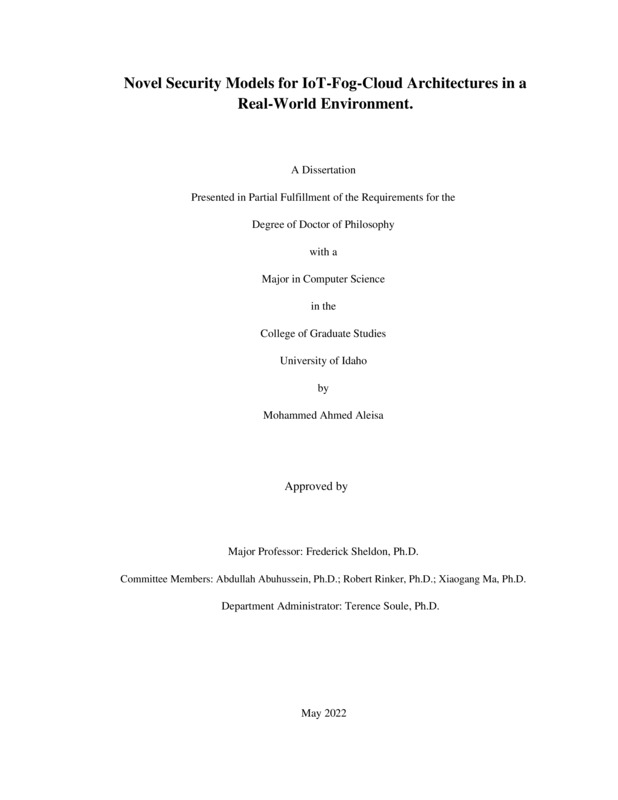Novel Security Models for IoT-Fog-Cloud Architectures in a Real-World Environment
Aleisa, Mohammed Ahmed . (2022-05). Novel Security Models for IoT-Fog-Cloud Architectures in a Real-World Environment. Theses and Dissertations Collection, University of Idaho Library Digital Collections. https://www.lib.uidaho.edu/digital/etd/items/aleisa_idaho_0089e_12314.html
- Title:
- Novel Security Models for IoT-Fog-Cloud Architectures in a Real-World Environment
- Author:
- Aleisa, Mohammed Ahmed
- ORCID:
- 0000-0002-7015-413
- Date:
- 2022-05
- Embargo Remove Date:
- 2022-10-22
- Keywords:
- Access Control Cloud Computing Fog Computing Internet of Things Performance Metrics Security requirements
- Program:
- Computer Science
- Subject Category:
- Computer science
- Abstract:
-
The emergence of the Internet of things (IoT) has generated demand for computation performed at the ‘edge’ of the network. With companies being increasingly challenged to collect and send data collected from IoT devices to the cloud, this increases the need for fog computing. Fog computing is an intermediate computing layer that has emerged to address the latency issues of cloud-based Internet of things (IoT) environments. As a result, new forms of security and privacy threats are emerging. These threats are mainly due to the huge number of sensors, as well as the enormous amount of data generated in IoT environments that needs to be processed in real time. These sensors send data to the cloud through the fog computing layer, creating an additional layer of vulnerabilities. In addition, the cloud by nature is vulnerable because cloud services can be located in different geographical locations and provided by multiple service providers. Moreover, cloud services can be hybrid and public, which exposes them to risks due to their infinite number of anonymous users. This research proposed two architectures of cloud-based IoT environments and three analysis methods. The two proposed architectures are evaluated based on the three analysis methods to show the efficacy of the fog layer in different experiments in a real-world environment by examining performance metrics on the cloud and fog layers using different numbers of IoT devices. To overcome the security challenges between the IoT layer and fog layer and, thus, meet the security requirements, this research also proposed a fine-grained data access control model based on the attribute-based encryption of the IoT–Fog–Cloud architecture to limit the access to sensor data and meet the authorization requirements. In addition, this research proposed a blockchain-based certificate model for the IoT–Fog–Cloud architecture to authenticate IoT devices to fog devices and meet the authentication requirements. We evaluated the performance of the two proposed security models using AWS cloud metrics to determine their efficiency in real-life experiments of the IoT–Fog–Cloud architecture.
- Description:
- doctoral, Ph.D., Computer Science -- University of Idaho - College of Graduate Studies, 2022-05
- Major Professor:
- Sheldon, Frederick
- Committee:
- Abuhussein, Abdullah; Rinker, Robert; Ma, Xiaogang; Soule, Terence
- Defense Date:
- 2022-05
- Identifier:
- Aleisa_idaho_0089E_12314
- Type:
- Text
- Format Original:
- Format:
- application/pdf
- Rights:
- In Copyright - Educational Use Permitted. For more information, please contact University of Idaho Library Special Collections and Archives Department at libspec@uidaho.edu.
- Standardized Rights:
- http://rightsstatements.org/vocab/InC-EDU/1.0/

